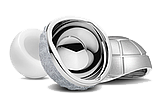At a glance
- The S curvature follows the natural anatomical shape of the femur
- Ribbed profile for high primary stability and structural elasticity1-3,7
- Bone preserving
- Minimally invasive implantation
- LINK HX coating

LINK is one of the pioneers of anatomical prosthesis design, and has decades of experience in the development of these stem types. The impressive clinical success of the SP II concept is well documented in the Swedish Register. 2
LINK has taken this prosthesis system a step further by developing the cementless version SP-CL.
We have taken clinically proven design features of the cemented SP II prosthesis and combined them with the requirements of a cementless hip stem to create a harmonized prosthesis system, following the principle “Anatomy defi nes form”.
The special implant design conserves bone and soft tissue 3, while the wide range of implants permits the individual adaption to each patient’s anatomy. 4
The system is accompanied by a compact, ergonomic instrument set, which enables the surgeon to perform the arthroplasty smoothly and efficiently. 3
Features of the SP-CL Hip System:

Anatomical Design

Conserves bone and soft tissue 4

Rotational stability 5, 6, 7

Wide range of sizes

Ribbed profile for structural elasticity 6

Wide choice of versions
Anatomical design
The anatomical S-shape effectively reduces stress risers and the associated risk of thigh pain, which are a familiar problem with three-point fixation of straight stems. At the same time, it lends the implant greater rotational stability.6, 7, 8

Trochanter protection
Protects the greater trochanter due to flattened proximal lateral profile.4

Tapered, polished distal prosthesis tip
The polished distal section of the stem facilitates implantation while also reducing the incidence of thigh pain, which can be caused by intramedullary fixation of a hip implant.3, 13, 14


High primary stability and reduction of stress shielding
The clinically proven ribbed structure serves to anchor the stem in the compressed cancellous bone and
provides high primary stability. 6, 11, 12
In combination with the LINK Tilastan-S alloy, the known elasticity of the material itself is, most importantly, supplemented by the structural elasticity of the stem design in order to reduce stress shielding.5, 6

LINK HX (CaP) coating
The osteoconductive surface promotes bone ongrowth.9
Related products
All productsSources
- W.T. Stillwell. (1987). The Art of Total Hip Arthroplasty. Grune & Stratton, pp. 296.
- Annual Report 2016; Swedish Hip Arthroplasty Register; www.shpr.se.
- Internes Dokument W. Link
- Vidalain, J. P., et al. (2011). The Corail Hip System. A practical approach based on 25 years of experience. Springer Heidelberg. pp. 54.
- Pipino, F., Keller, A. (2006). Tissue-sparing surgery: 25 years’ experience with femoral neck preserving hip arthroplasty. Journal of Orthopaedics and Traumatology, 7(1), pp. 36-41.
- Langhans, M., Hofman, D., Ecke, H., & Nietert, M. (1992). Der Einfl uß der Formgebung des Prothesenschaftes auf die Beanspruchung des proximalen Femurs. Unfallchirurgie, 18(5), pp. 266-273.
- Noble, P., Alexander, J., Lindahl, L., Yew, D., Granberry, W., & Tullos, H. (1988). The anatomic basis of femoral component design. Clinical Orthopaedics and Related Research (235), pp. 148-165.
- Denaro, V., & Fornasier, V. (2000). Fill, fi t and conformation - an anatomical and morphometric study of a hip component in total hip arthroplasty (Rippen-Link). European Journal of Orthopaedic Surgery & Traumatology, 10(4), pp. 239-247.
- Palm, L., Jacobsson, S., & Ivarsson, I. (2002). Hydroxyapatite coating improves 8- to 10-year performance of the link RS cementless femoral stem. The Journal of Arthroplasty, 17(2), pp. 172-175.
- DiGiovanni, C.W., Garvin, K.L., Pellicci, P.M. (1999). Femoral preparation in cemented total hip arthroplasty: reaming or broaching? Journal of the American Academy of Orthopaedic Surgeons, 7(6), pp.349-357.
- Schill S, Thabe H. (2000). Long- and Mid-Term Results of the Cementless Link Prosthetic System in Combination with the Ribbed Stem and Screw-in Cup, Type “V”. Orthopädische Praxis, 36, pp. 160-167.
- Thabe H, Wolfram U, Schill S. (1993). Medium-term results using the cement-free link endoprosthesis. Ribbed shaft V socket. Zeitschrift fur Orthopädie und ihre Grenzgebiete, 131(6), pp. 568-573.
- Petrou, G., Gavras, M., Diamantopoulos, M., Kapetsis, T., Kremmydas, N., & Kouzoupis, A. (1994). Uncemented total hip replacements and thigh pain. Archives of Orthopaedic and Trauma Surgery, 113(6), pp. 322-326.
- Khanuja, H., Vakil, J., Goddard, M., & Mont, M. (2011). Cementless femoral fi xation in total hip arthroplasty. The Journal of Bone & Joint Surgery, 93(5), pp. 500-509.







